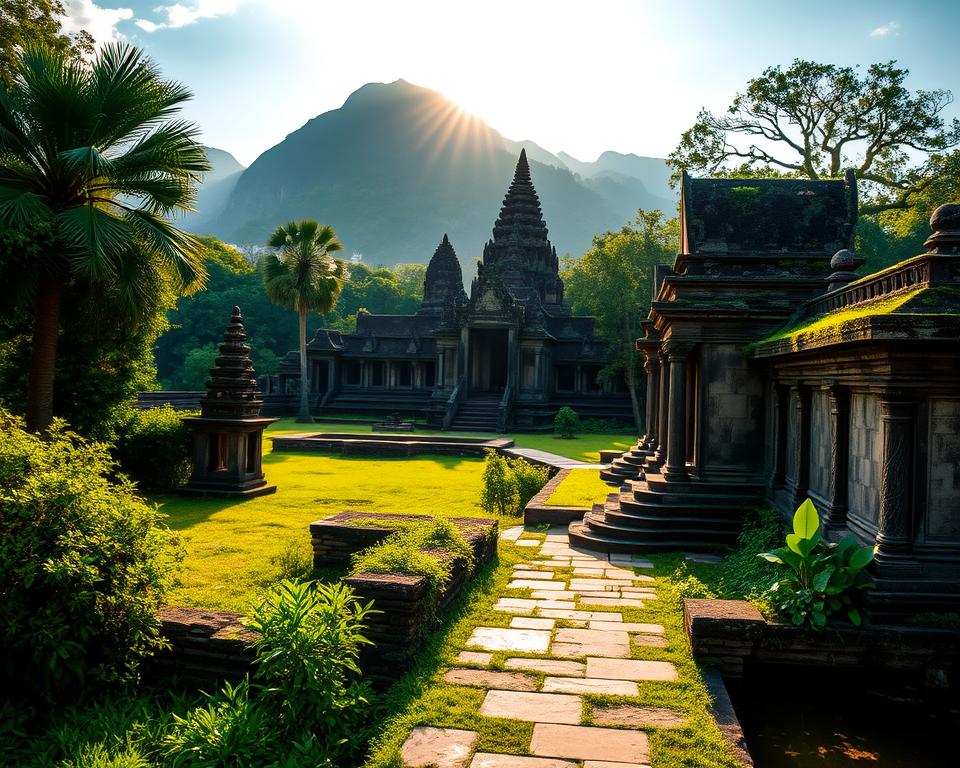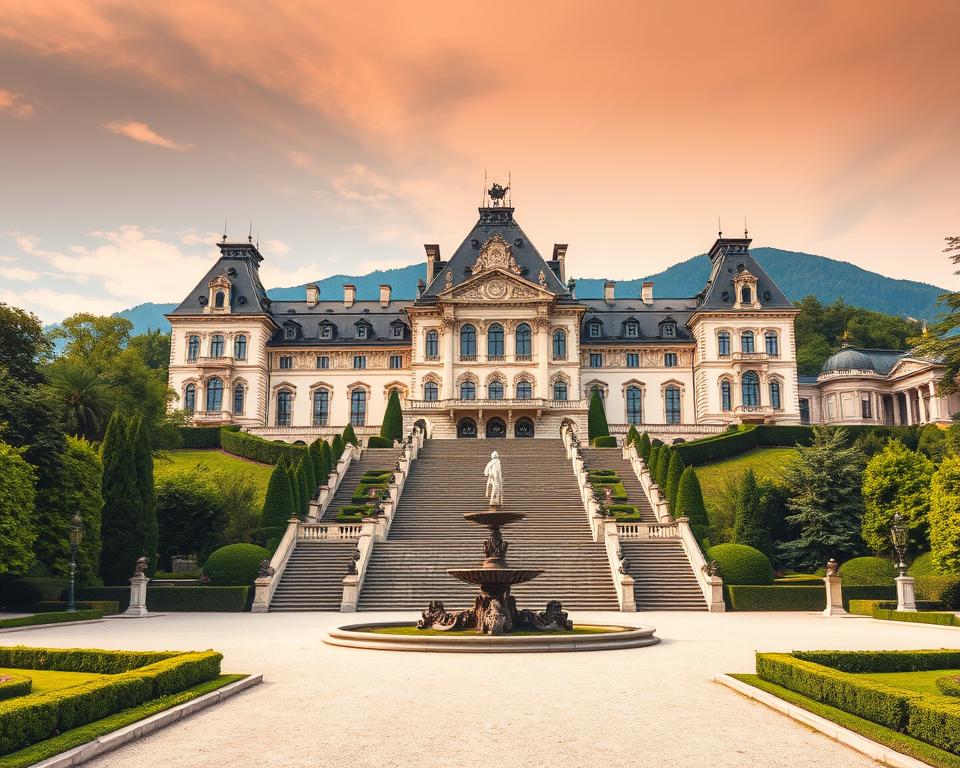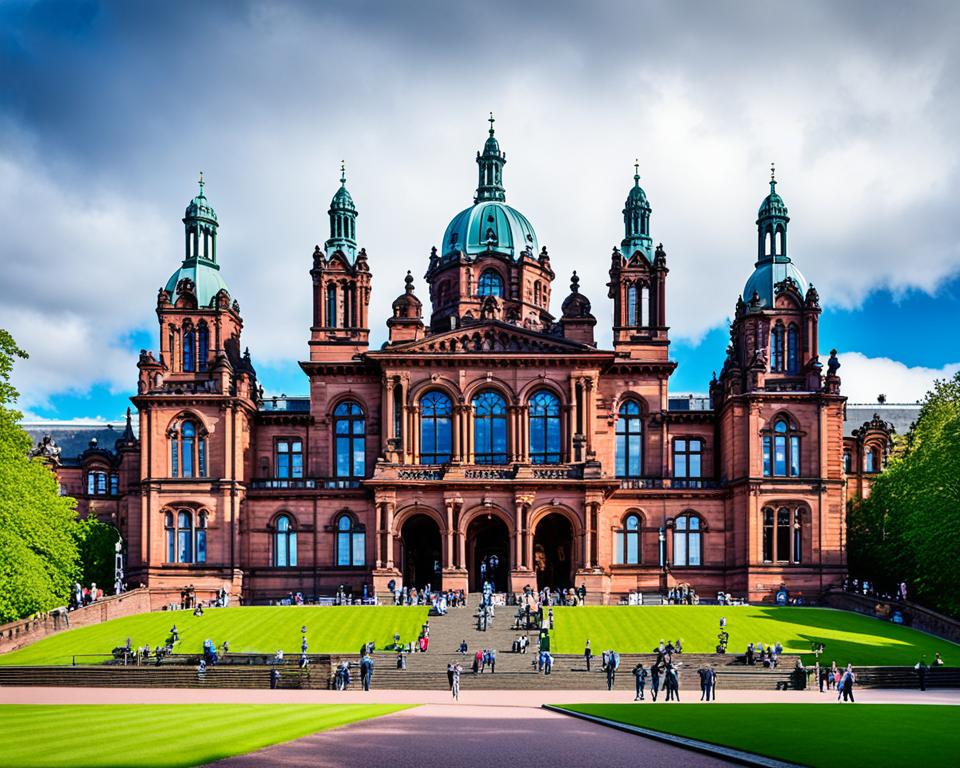In southern Laos, by the Mekong River, lies Vat Phou. It’s an ancient Khmer temple complex that has amazed people for ages. This UNESCO World Heritage site shows the Khmer Empire’s great achievements, beyond today’s Cambodia.
Vat Phou gives us a peek into the area’s rich culture. It’s one of the best-preserved Khmer buildings outside Angkor Wat. This sacred place symbolizes the Khmer civilization’s lasting influence on the Mekong River area.
Read interesting things at : trainwithnexus
Key Takeaways
- Vat Phou is an ancient Khmer temple complex located in southern Laos, a UNESCO World Heritage site.
- The temple complex is a testament to the remarkable achievements and far-reaching influence of the Khmer Empire.
- Vat Phou offers a unique glimpse into the pre-Angkorian architectural style and the rich cultural heritage of the Mekong River region.
- The site is well-preserved, showcasing the enduring legacy of Khmer civilization and its impact on the broader Mekong River civilization.
- Visitors can explore the site’s Hindu-Buddhist roots, connections to the Angkor civilization, and the larger Laotian archaeological landscape.
Unveiling the Majestic Vat Phou
Introduction to Vat Phou
The ancient Khmer temple complex of Vat Phou is located on the Mekong River’s banks. It showcases the architectural skills and cultural depth of the pre-Angkorian civilization. Built in the 5th century AD, it predates Angkor Wat, giving us a peek into the Khmer Empire’s early days.
Historical Significance of the Khmer Empire
The Khmer Empire was a mighty force in Southeast Asia from the 9th to 15th centuries. Vat Phou, a pre-Angkorian site, sheds light on the empire’s early growth and cultural changes. Its ancient architecture and religious themes show the Khmer civilization’s strong roots long before Angkor Wat was built.
“Vat Phou stands as a testament to the architectural prowess and cultural richness of the pre-Angkorian Khmer civilization.”
Vat Phou was a key part of the Mekong River civilization, crucial to the Khmer Empire’s early development. This temple complex offers a glimpse into the artistic, religious, and political forces that shaped the Angkor era.
Architectural Marvels of the Vat Phou Complex
The Vat Phou complex in Laos is a marvel of ancient Khmer architecture. It shows the beauty of the pre-Angkorian style. This style mixes Hindu and Buddhist designs, showing the Mekong River civilization’s rich culture.
The layout of Vat Phou is fascinating. Its central temple sits on a sacred mountain. The walls are covered in stone carvings of myths and gods. These carvings show the early Khmer artisans’ skill.
Pre-Angkorian Architectural Influences
The Vat Phou complex’s design is from the pre-Angkorian style, from the 5th to 8th centuries CE. This style combines religious and secular elements. It blends Hindu and Buddhist motifs smoothly.
The use of sandstone at Vat Phou is striking. It’s perfect for the detailed carvings and decorations. The carvings show the Khmer people’s artistic skill during this time.
| Architectural Element | Description |
|---|---|
| Stepped Pyramid | The central sanctuary of Vat Phou is built upon a stepped pyramid, a design feature commonly found in pre-Angkorian architecture. |
| Stone Carvings | Elaborate stone carvings depicting deities, mythological scenes, and symbolic motifs adorn the temple walls and structures. |
| Harmonious Integration | The Vat Phou complex seamlessly blends Hindu and Buddhist architectural elements, reflecting the religious and cultural diversity of the period. |
The Vat Phou complex is a great example of pre-Angkorian architecture. It shows the early Khmer civilization’s art and culture along the Mekong River.
Vat Phou: A UNESCO World Heritage Site
In 2001, Vat Phou and the Champasak Cultural Landscape were named a UNESCO World Heritage Site. This honor recognizes their value and importance in Laotian archaeology and culture.
This ancient Khmer temple complex is in southern Laos. It has amazed visitors and scholars with its design, history, and spiritual importance. The UNESCO status highlights its cultural and historical significance, making it a key place to visit in the Champasak cultural landscape.
Preserving the Past, Inspiring the Future
The UNESCO World Heritage status boosts Vat Phou‘s profile and ensures its preservation for future generations. The Laotian government, local communities, and international groups work together. They aim to keep the site’s ancient temples, shrines, and landscapes safe.
By naming Vat Phou a UNESCO World Heritage Site, the world recognizes its importance in Laotian archaeology and shared cultural heritage. This status also brings more attention and resources. It supports research, conservation, and community projects, keeping the Champasak cultural landscape alive and inspiring.
| Fact | Detail |
|---|---|
| UNESCO World Heritage Designation | Vat Phou and the Champasak Cultural Landscape were designated as a UNESCO World Heritage Site in 2001. |
| Cultural Significance | The site is recognized for its outstanding universal value and pivotal role in Laotian archaeology and cultural heritage. |
| Preservation Efforts | Collaborative efforts between the Laotian government, local communities, and international organizations are dedicated to preserving the ancient temples, shrines, and surrounding landscapes. |
| Increased Attention and Resources | The UNESCO designation has brought greater attention and resources to support ongoing research, conservation, and community engagement initiatives at the Champasak cultural landscape. |
“The UNESCO World Heritage status of Vat Phou and the Champasak Cultural Landscape is a testament to the site’s enduring cultural and historical significance, as well as the collective efforts to preserve this priceless legacy for future generations.”
Exploring the Champasak Cultural Landscape
Beyond the Vat Phou temple complex lies the Champasak Cultural Landscape. This area is rich in history, showing the Mekong River civilization’s impact. It reveals the Laotian archaeology and the temple complex before Angkor.
Surrounding Archaeological Wonders
The Champasak Cultural Landscape is filled with ancient temples, settlements, and natural spots. These ruins give us a peek into the past. Each pre-Angkorian structure has its own story and cultural importance.
- The Thao Tao Temple is a well-preserved example of Laotian archaeology. It shows the region’s intricate craftsmanship and mix of Hindu-Buddhist influences.
- Ban Mouang archaeological site has ancient settlements’ remains. It gives us a glimpse into the lives of the people who lived in Champasak.
- The Khone Phapheng Falls and Phou Asa mountain are natural wonders. They add to the Champasak Cultural Landscape‘s beauty.
These sites and natural wonders show the rich culture of Vat Phou and its surroundings. They invite visitors to explore the fascinating history of this area.
| Archaeological Site | Notable Features | Significance |
|---|---|---|
| Thao Tao Temple | Intricate architectural details, Hindu-Buddhist influences | Showcases the rich cultural heritage of the region |
| Ban Mouang | Remnants of ancient settlements, insights into daily life | Provides valuable information about the region’s past inhabitants |
| Khone Phapheng Falls | Stunning natural wonder, part of the Champasak landscape | Adds to the overall allure and cultural significance of the region |
Unraveling the Hindu-Buddhist Roots
The Vat Phou complex in Laos is a fascinating example of Hindu and Buddhist influences. It shows how these beliefs mixed in the pre-Angkorian era of the Mekong River civilization. This pre-Angkorian temple complex is a blend of architectural styles and symbols, revealing the area’s rich culture.
At Vat Phou’s core, we find a mix of Hindu and Buddhist elements. The temples, shrines, and carvings here reflect the blending of religious practices in the Mekong River region. The Hindu-Buddhist monuments at Vat Phou remind us of the region’s dynamic religious scene, where different beliefs merged.
“Vat Phou is a remarkable example of the blending of Hindu and Buddhist architectural and religious elements that characterized the pre-Angkorian period in Southeast Asia.”
The vat phou complex is a mix of architectural styles, with influences from Hindu and Buddhist traditions. Its layout, with tiered structures and symbols, shows Hindu cosmology. Yet, the presence of Buddhist statues and sanctuaries highlights the area’s spiritual diversity.
Vat Phou’s importance goes beyond its physical beauty. It shows the region’s connected history and the lasting impact of the Mekong River civilization. This site invites visitors to discover the intricacies of pre-Angkorian beliefs and culture, offering a unique look into Southeast Asia’s past.
Vat Phou and the Angkor Civilization
The Vat Phou temple is older than Angkor Wat. Yet, it’s closely tied to the Angkor civilization and the Khmer Empire. Its architecture and religious themes show how Khmer culture and buildings evolved over time.
The pre-Angkorian temple complex of Vat Phou was key before the Angkor Empire. Its design, with many sanctuaries and courtyards, inspired Angkor Wat and other Khmer wonders.
Echoes of the Past
Vat Phou’s influence is seen in its naga-guarded staircases and intricate stone carvings. These features became symbols of the Angkorian style, showing the ongoing cultural exchange.
The temple’s mix of Hindu and Buddhist elements is also seen in Angkorian monuments. This highlights the Khmer Empire’s spiritual traditions and architectural legacy.
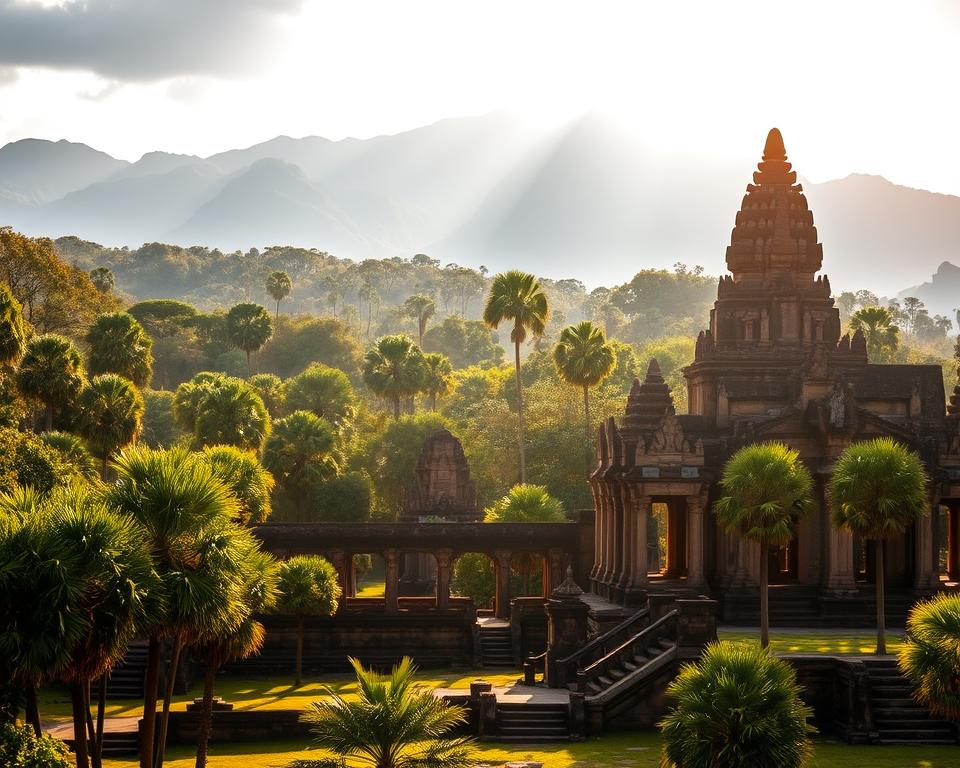
“Vat Phou stands as a testament to the enduring creative spirit of the Khmer people, serving as a precursor to the magnificent wonders of the Angkor civilization.”
Laotian Archaeology: Preserving the Past
In the heart of Laos, the ancient temple complex of Vat Phou stands as a testament to the rich cultural heritage of the region. Laotian archaeologists and heritage professionals have been at the forefront of preserving and studying this remarkable site. They ensure its continued recognition as a UNESCO World Heritage Site. This shows Laos’ commitment to safeguarding its national treasures.
The Champasak Cultural Landscape, which includes Vat Phou, has been the focus of extensive archaeological research and conservation efforts. Laotian experts have worked tirelessly to uncover the site’s secrets. They have pieced together the story of the Khmer Empire’s influence in the region and the enduring legacy of the ancient Mekong River civilization.
Through their dedication and expertise, Laotian archaeologists have not only preserved the physical structures of Vat Phou. They have also shed light on the site’s cultural and religious significance. Their work has been invaluable in understanding the intricate connections between Laotian archaeology and the broader Angkor civilization that dominated the region for centuries.
| Key Achievements in Laotian Archaeology | Impact |
|---|---|
| Comprehensive documentation and preservation of Vat Phou | Maintained the site’s historical integrity and UNESCO World Heritage status |
| Extensive research on the Champasak Cultural Landscape | Deepened understanding of the region’s ancient Khmer and Mekong River civilizations |
| Collaboration with international partners for conservation efforts | Secured funding and technical expertise to safeguard Laos’ cultural heritage |
The unwavering commitment of Laotian archaeologists to Vat Phou and the broader Champasak Cultural Landscape has been instrumental in preserving these invaluable assets for future generations. Through their tireless efforts, the rich cultural history of Laos continues to be celebrated and shared with the world.
“Preserving the past is not just about protecting ancient structures, but about honoring the stories and traditions that shape a nation’s identity.”
Mekong River Civilization: A Cradle of Culture
The Mekong River has always been key, connecting cultures and sparking civilizations in Southeast Asia. The Khmer Empire thrived here. Vat Phou, by the river, was a major trade, religious, and artistic center before the Angkorian era.
The Mekong River civilization began in the early first millennium CE. It was a melting pot of cultures, each with its own stories and traditions. The Vat Phou temple, a pre-Angkorian temple by the Mekong, shows the era’s architectural and cultural peaks.
The ancient Khmer architecture at Vat Phou is stunning, with detailed carvings and symbols. It shows the area’s strong Hindu-Buddhist roots. This site was more than a temple; it was a hub for trade and politics in the Mekong River civilization.
“Vat Phou’s strategic location along the Mekong River highlights the site’s importance as a center of regional trade, religious influence, and artistic expression during the pre-Angkorian period.”
The Mekong River and its lands have always been rich in culture. They shaped many civilizations and left a lasting impact on history. Vat Phou, as a pre-Angkorian temple complex, celebrates the legacy of the Mekong River civilization.
| Architectural Elements | Influence |
|---|---|
| Sandstone Towers | Hindu-Buddhist Symbolism |
| Intricate Carvings | Artistic Expression of Regional Culture |
| Tiered Structures | Representation of Cosmic Order |
| Orientation Towards Mekong River | Integration with Natural Landscape |
Vat Phou: A Spiritual Sanctuary
Vat Phou is a magnificent temple complex in Laos with deep spiritual meaning. It’s a sacred site for Hindus and Buddhists, attracting pilgrims from the Mekong River area. People come here to perform rituals and seek spiritual growth.
The temple sits in the lush Champasak landscape, perfect for contemplation. Its calm atmosphere invites visitors to reflect and connect with the divine. The blend of nature and architecture creates a special spiritual experience.
The vat phou complex is filled with Hindu and Buddhist symbols. These symbols show the mix of religions in the area. Visitors can see detailed carvings and sculptures that have been important for many years.
“Vat Phou is not just a monument, but a living testament to the enduring spiritual legacy of the Mekong River civilization. Its timeless allure continues to captivate and inspire all who come to seek solace and guidance within its hallowed grounds.”
The spiritual value of vat phou is enhanced by its connection to the Champasak cultural landscape. This area is full of archaeological wonders and ancient temples. Together, they show the deep connection between nature and the divine.
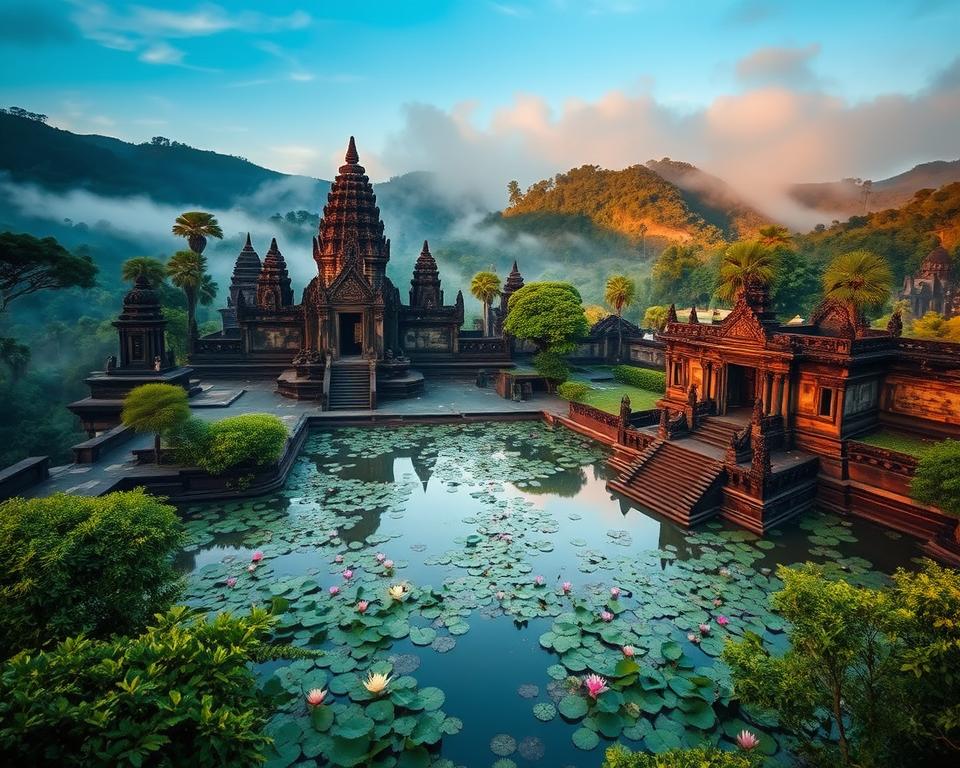
As a UNESCO World Heritage Site, vat phou attracts visitors worldwide. It inspires awe and reverence, showing the lasting impact of the Mekong River civilization. The pre-angkorian temple complex has shaped the region’s rich heritage.
Ancient Khmer Architecture: Timeless Beauty
The Vat Phou complex in Laos is a marvel of ancient Khmer architecture. It sits on the banks of the Mekong River civilization. This temple, built in the pre-Angkorian style, shows the Khmer people’s artistic vision and engineering skills.
Design Elements and Craftsmanship
The temple’s walls are covered in stone carvings. Its symmetrical layout is a sign of the ancient Khmer architecture‘s detail. The temple blends with the natural surroundings, like the sacred mountain and the river, showing the Khmer’s deep connection with nature.
- Intricate stone carvings and sculptures
- Symmetrical and harmonious architectural layout
- Seamless integration of natural elements
The work at Vat Phou shows the skill and creativity of the pre-Angkorian Khmer. This site draws visitors worldwide, offering a look into the beauty of ancient Khmer architecture.
“The Vat Phou complex stands as a testament to the enduring legacy of the Khmer people, whose architectural and engineering prowess continues to inspire awe and wonder.”
Visiting Vat Phou: A Journey Through Time
Visiting Vat Phou in Laos is a chance to dive into the area’s rich history. It’s a UNESCO World Heritage Site and the heart of the Champasak cultural landscape. Here, you can explore the ancient Khmer civilization’s history and architecture.
Practical Tips for Travelers
Here are some tips to enhance your visit to Vat Phou:
- Get there early to beat the heat and crowds. This lets you enjoy the site at your own pace.
- Wear comfy shoes for walking. The temple complex has stairs and uneven paths.
- Don’t forget sun protection like hats, sunscreen, and water. Stay cool while exploring.
- Check out the visitor center or join a guided tour. They can help you see the most important parts.
- Think about taking a boat ride on the Mekong River. It’s a great way to see the area’s beauty and history.
By planning well and following these tips, you’ll get the most out of your visit to Vat Phou. You’ll enjoy the history and the beautiful surroundings of this ancient Khmer site.
Conclusion
Vat Phou is a wonder of the Khmer Empire, showing the rich culture of Southeast Asia. It’s a UNESCO World Heritage site, known for its stunning architecture and mix of Hindu and Buddhist styles. The Mekong River, which runs through it, has seen many empires come and go. Yet, Vat Phou remains a sacred place and a bridge to the past.
The carvings and buildings at Vat Phou show the creativity of the Khmer people. It draws scholars, archaeologists, and travelers who want to learn about the Khmer Empire. They aim to understand its lasting influence on the Mekong River civilization.
Leaving Vat Phou, we gain a new respect for Southeast Asia’s cultural heritage. It’s a mix of history, spirituality, and the Khmer people’s strength. This site proves the beauty and importance of Khmer architecture and culture.
